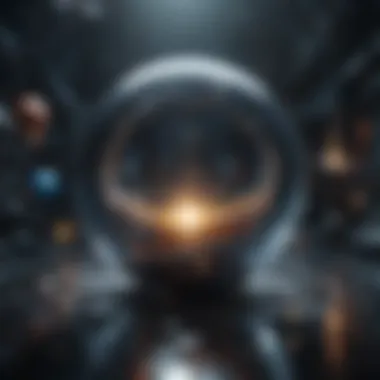Exploring the Depths of Multiverse Theory


Intro
The multiverse theory has emerged as a prominent topic within modern physics and cosmology, captivating both scientists and philosophers alike. It proposes a framework in which our universe is but one of many, possibly infinite, universes that exist concurrently. This concept raises profound questions about the nature of reality and invites inquiry into the fundamental structures of existence. Examining this theory not only expands our understanding of the universe but also challenges traditional perceptions of space and time.
The discussions surrounding the multiverse are diverse and complex. Researchers investigate its scientific validity and delve into philosophical implications, debating whether such a multiplicity of universes is necessitated by current theories, such as quantum mechanics and string theory. As we embark on this exploration of the multiverse, it becomes important to highlight key research findings that shape our understanding of the subject.
Preamble to the Multiverse Theory
The concept of the multiverse is both captivating and complex. This theory suggests that our universe is just one of many, possibly infinite universes that exist side by side. By exploring the multiverse, we can gain a better understanding of fundamental questions about existence, reality, and the nature of the cosmos. In this article, we will navigate through various key elements of the multiverse theory.
Definition and Overview
The term "multiverse" refers to the idea of multiple universes existing simultaneously. Each universe within this framework can operate under different fundamental laws and constants. This notion extends far beyond our limited view of reality, suggesting a landscape that is rich and varied, filled with universes that may differ in their physical attributes.
From science fiction to theoretical physics, the multiverse concept has gained traction in various fields. Its relevance is underlined by the shifting paradigms in the understanding of space and time, with researchers seeking to explore questions that were once regarded as philosophical. For instance, one key aspect of the multiverse theory is its implications for cosmology and the fabric of reality.
Historical Evolution of the Concept
Ancient Philosophical Roots
The idea of multiple worlds has ancient philosophical origins. In ancient Greece, philosophers like Democritus speculated about the existence of other worlds. He believed in a universe composed of countless atoms interacting in various ways, potentially giving rise to different realities. This philosophical groundwork is significant because it frames our modern inquiry into the multiverse. It indicates an early inclination to explore beyond the observable universe, an urge that continues today.
Key characteristics of these ancient ideas include an intuitive grasp of the infinite nature and a basic understanding of atomic theory. This has become a beneficial aspect for further scientific investigation, as it provides a historical basis for current multiverse theories. The uniqueness of ancient philosophical discussions lies in their attempt to rationalize the universe despite the lack of advanced scientific tools. This early curiosity sets a precedent for later developments in the understanding of the cosmos.
The Enlightenment Era
During the Enlightenment, thinkers like Leibniz and Hume contributed to the discourse surrounding multiple universes. Leibniz argued for the existence of a plurality of worlds underpinned by a rational order that guides them. Hume, meanwhile, promoted a skepticism that ultimately led to deeper philosophical inquiries regarding existence.
One key characteristic of the Enlightenment discussion is its shift towards reason and empirical evidence. It allowed for a wider acceptance of ideas that challenged traditional religious explanations of the universe. This openness enhances the relevance of the multiverse concept today, as it aligns with current scientific methodologies. The unique feature of this era was its emphasis on logical reasoning, which remains critical in the debate surrounding the multiverse theory.
Twentieth-Century Physics
The 20th century marked significant advancements in physics that propelled the multiverse theory into the mainstream scientific conversation. Quantum mechanics and the development of cosmological models laid crucial groundwork for these discussions. Notable figures like Hugh Everett III proposed the Many-Worlds Interpretation of quantum mechanics, suggesting that all possible outcomes of quantum events occur in parallel universes.
The fundamental characteristic of this scientific evolution is its reliance on empirical data and mathematical rigor. It transitions from speculative philosophy to a realm backed by theoretical physics. This shift adds considerable weight to the multiverse debate, as it encourages testing and validation of the theories presented.
The advantage of employing a scientific framework is clear. It allows a more structured exploration of what it means to exist within a multiverse, presenting possibilities that can be further examined through mathematics and observations. As we delve deeper into these concepts, we prepare to explore their implications, challenges, and potential future directions.
Types of Multiverse Theories
The exploration of Types of Multiverse Theories is central to understanding how different scientific principles and philosophical ideas intersect. In this section, we will dissect the leading theories that conceptualize the multiverse. Each theory provides a unique lens through which we can view the cosmos, allowing us to grasp various implications for reality, existence, and our place within the known universe.
Many-Worlds Interpretation
The Role of Quantum Mechanics
The Many-Worlds Interpretation, proposed by Hugh Everett III in 1957, is a significant aspect of quantum mechanics. This interpretation suggests that all possible outcomes of quantum measurements are realized, with each possibility existing in its own branch of the universe. A key characteristic here is the idea that the universe splits into multiple, non-communicating branches with each event, shaping different realities. This interpretation is appealing because it provides a coherent understanding of quantum phenomena without the need for wave function collapse.


However, it is not without its challenges. Critics argue about the lack of empirical testability and the implications it holds for determinism. In this article, we highlight this as a beneficial choice because it addresses fundamental questions in quantum mechanics and challenges traditional notions of reality.
Implications for Determinism
The Many-Worlds Interpretation raises profound implications for determinism. If every outcome occurs in some branch of reality, it suggests that free will, as commonly understood, may not exist in the traditional sense. The key characteristic in this discussion is how decisions create divergent paths rather than a single outcome.
This viewpoint is beneficial for its potential to reshape our understanding of agency and choice. However, it faces counterarguments regarding the meaning of choice if all outcomes are predetermined in different realities. In this context, it serves as a unique feature inviting further philosophical exploration into the limits of human understanding.
Cosmic Inflation Theory
Foundations of Cosmological Models
Cosmic Inflation Theory, initially proposed by Alan Guth in the 1980s, examines the rapid expansion of the universe just after the Big Bang. This theory serves as a foundational concept for many cosmological models, significantly impacting our understanding of cosmic structure and evolution. It suggests that quantum fluctuations during this inflationary period could give rise to multiple universes. This is a popular choice for many scientists because it aligns with observations of the cosmic microwave background radiation.
The unique feature of this model lies in its vast explanatory power concerning the homogeneity and isotropy of the universe. However, its speculative nature can also be seen as a disadvantage, as it hinges on the unproven assumption that inflation occurred as theorized.
Bubble Universes and Their Characteristics
The notion of Bubble Universes emerges from Cosmic Inflation Theory, where each bubble corresponds to a different universe that forms in a multiverse context. Each bubble universe may have different physical constants, leading to varied properties and laws of physics. A key characteristic here is the independence of these bubbles from each other, hinting at a complex structure of the multiverse.
This concept is beneficial in explaining the fine-tuning of our universe; different bubbles could explain the diversity observed in physical constants across potential universes. Nevertheless, the challenge remains with procuring direct evidence for the existence of these bubble universes, which limits their acceptance in mainstream physics.
String Theory and the Landscape Multiverse
The Mathematical Framework of String Theory
String Theory offers a rich mathematical framework that provides a basis for the landscape multiverse. At its core, string theory postulates that the fundamental constituents of the universe are one-dimensional strings rather than point particles. This theory is significant as it attempts to unify quantum mechanics and general relativity. A key characteristic is its propensity to yield numerous consistent vacuum states, projecting a large landscape of possible universes.
This framework is a popular choice in theoretical physics because it allows physicists to consider various scenarios for particle properties. The unique feature here is its versatility in addressing unresolved issues in theoretical frameworks. However, string theory also faces criticism for a lack of empirical evidence and for being highly mathematical, making it less accessible to observational science.
Vacuum States and Universe Configurations
In the landscape multiverse concept, different vacuum states correspond to different physical laws and constants. Each configuration of the vacuum state contributes to a distinct universe. A key element to understand is how variations in these vacuum states can give rise to diverse universes, with potential implications for their stability and characteristics.
This aspect is beneficial as it provides a framework for understanding why our universe has specific properties favorable for life. Yet, it also presents disadvantages, as it leads to questions about the origin of such vacuum states and whether they can ever be tested or observed directly.
"The multiverse implies that everything that can happen does happen, but what this means for our understanding of reality is still unfolding."
This section contributes vital insights into multiverse theories by examining their foundations and implications. With careful analysis of each theory, our understanding of the cosmos expands, inviting further inquiry into the nature of existence.
Scientific Evidence and Supporting Theories
Cosmic Background Radiation
Cosmic Background Radiation (CBR) refers to the afterglow radiation that fills the universe, a remnant from the Big Bang. This radiation provides crucial evidence for the conditions of the early universe. For multiverse theory supporters, CBR has implications that reach beyond explaining our universe's formation.
The uniformity of CBR indicates a smooth and homogeneous early universe. However, some interpretations suggest that slight fluctuations in this background radiation could imply the presence of other universes. The theory posits that if our universe is but one of many within a larger multiverse, variations in CBR might arise from encounters or interactions with neighboring universes, or even different bubbles formed during cosmic inflation. Understanding the CBR adds layers to multiverse theories, highlighting how observational astrophysics might intersect with speculative cosmology.
"Cosmic Background Radiation presents a critical piece of data that fuels the multiverse debate, demonstrating the remarkable ways in which our own universe might relate to others."


Observational Limitations and Challenges
Despite intriguing hypotheses, observational limitations pose significant challenges in substantiating multiverse theories. Current technology largely restricts our ability to observe or gather data outside our observable universe. This limitation raises fundamental questions about the validity of multiverse claims.
Key considerations include:
- Technological Constraints: The instruments available for cosmological observations are limited. Detecting signals from other universes remains out of reach, restricting empirical evidence.
- Lack of Testability: Many multiverse theories may not be testable using conventional scientific methods. This raises skepticism in the scientific community, as theories that do not allow for verification are often dismissed.
- Philosophical Implications: The difficulties in observation introduce philosophical questions about the nature of reality and what constitutes scientific proof. The balance between theoretical models and practical observation becomes essential in multiverse discussions.
The interplay of these challenges means that while multiverse theories present fascinating possibilities, substantial work remains before they could achieve wider acceptance within the scientific community.
Philosophical Implications
The exploration of philosophical implications surrounding the multiverse theory serves as a bridge between scientific inquiry and existential contemplation. This area of study invites questions about the fundamental nature of reality, the concept of free will, and the implications these theories may have on our understanding of existence itself. The multiverse prompts us to consider whether our universe is unique or merely one of countless variations. This inquiry holds significant value not only in physics but also in our broader understanding of human experience.
Nature of Reality
The notion of multiple universes challenges traditional conceptions of reality. If the multiverse theory is valid, reality becomes a vast tapestry woven from an array of potential outcomes and diverse worlds. Each universe may host different laws of physics, alternate histories, and varying degrees of consciousness. This leads to several philosophical considerations:
- Ontological Considerations: What does it mean for something to exist if there are infinite manifestations of reality? How do we define existence when alternatives to our reality could exist simultaneously?
- Epistemological Questions: Our method of understanding and knowing also comes into question. If there are multiple realities, how can we ascertain the nature of our own reality?
- Universal Laws and Constants: If every universe follows different physical laws, what is the role of our current understanding of physics? Are these laws truly universal, or are they merely local to our universe?
By engaging with these questions, we can better understand the implications of a multiverse and its potential to redefine reality.
Impacts on Free Will
The ramifications of multiverse theory extend to discussions about free will. If every decision results in the creation of parallel outcomes in different universes, one might argue that all choices are, in a sense, predetermined. This presents crucial philosophical impacts:
- Determinism vs. Indeterminism: The many-worlds interpretation suggests a deterministic nature of our universe. However, the existence of alternative universes where different decisions are made complicates this view, suggesting a form of indeterminism where every possibility plays out.
- Personal Agency: The belief in free will is often tied to the concept of making choices that significantly impact one’s life. If every choice exists in its separate universe, do individual decisions hold the gravity that we often assign to them?
- Moral Responsibility: If choices create divergent paths in reality, what does that mean for our accountability for those choices?
These questions highlight the profound philosophical challenges that arise when grappling with the multiverse theory, inviting deeper discourse about the implications for human behavior and moral philosophy.
"The multiverse, if true, would rewrite the principles we use to understand existence, agency, and morality."
This examination into the philosophical elements of the multiverse theory amplifies the significance of understanding phenomena beyond mere scientific constructs. It urges a reevaluation of our consciousness, our choices, and the very nature of existence in what may be a far larger cosmos than we comprehend.
Critiques and Controversies
Critiques and controversies surrounding the multiverse theory are essential for understanding its place in both scientific discourse and philosophical inquiry. As the theory suggests the existence of multiple universes, it raises significant questions about the nature of reality, existence, and the scientific framework itself. In this section, we will explore two primary areas of criticism: scientific skepticism and philosophical objections, both of which underline the complexities of accepting the multiverse as a valid concept in contemporary discussions.
Scientific Skepticism
Scientific skepticism plays a crucial role in the overall evaluation of the multiverse theory. Critics argue that many elements of this theory lack direct empirical support.
Challenges to Testability
Challenges to testability highlight a fundamental issue with the multiverse theory. Unlike theories that can be verified through experiments or observations, the multiverse notion often escapes traditional scientific methods. This aspect raises concerns about the scientific value of a theory that may not yield testable predictions. One significant characteristic of this challenge is its direct impact on how scientists evaluate theories. In particular, the lack of testability makes the multiverse theory less favorable among physicists who prioritize empirical data.
Moreover, the unique feature of this challenge lies in its relation to the scientific methodology itself. Scientific theories are generally expected to offer mechanisms where predictions can be made and either confirmed or denied. In the case of the multiverse, some consider it a speculative idea that lacks substantial grounding in testable science, which can lead to its dismissal. Consequently, this creates a disadvantage for the theory in gaining widespread acceptance in the scientific community.
The Role of Falsifiability


The concept of falsifiability is another statment of critical importance. Falsifiability indicates whether a theory can be disproven through evidence. For many scientists, the inability to refute the multiverse theory challenges its legitimacy as a scientific hypothesis. A key characteristic here is that falsifiability remains a cornerstone of scientific validation. The more a theory can be tested and potentially disproved, the stronger its position in scientific discourse.
The unique feature regarding falsifiability lies in the tendency of some theories to be immune to disproof. This raises philosophical dilemmas about what it means for a theory to be scientific. Advocates of the multiverse present it as a valuable framework for understanding complex cosmological phenomena. However, the lack of falsifiability can lead to skepticism, positioning the multiverse as an interesting but ultimately unproven notion.
Philosophical Objections
Philosophical objections provide further depth to the critique of the multiverse theory, challenging its implications on existence and knowledge.
Ontology and Epistemology
Ontology and epistemology are vital in discussing the philosophical aspects of the multiverse. Ontology investigates the nature of being, while epistemology concerns the study of knowledge. In the context of the multiverse, these two areas prompt questions about the validity of multiple universes in understanding reality. A principal characteristic is that these discussions underscore the need for a solid conceptual foundation when debating existence.
The unique feature of ontology and epistemology in relation to the multiverse raises questions about the criteria by which one defines the nature of existence. Critics argue that implying the existence of numerous universes threatens the coherence of what we consider "real." This point creates complexities in evaluating the multiverse theory from a philosophical perspective, making it a rich discussion for those interested in the implications of our understanding of existence.
Implications for Meaning and Purpose
The implications for meaning and purpose delve deeper into philosophical inquiry related to the multiverse. If multiple universes exist, what does this suggest about individual significance and the nature of choice? A standout characteristic of this discussion is the existential contemplation prompted by the multiverse theory.
The unique feature lies in the perspective that if each choice leads to an alternate universe, the importance of decisions may be diluted. This can lead to a crisis in personal meaning for some. It presents an advantage in addressing larger existential questions but also bears a disadvantage by potentially negating our understanding of human agency and purpose.
In summary, critiques and controversies enrich the discussion around the multiverse theory. They provide an essential framework for evaluating its scientific basis and philosophical implications.
Future Directions of Multiverse Research
The exploration of multiverse theory has grown significantly in recent years, opening pathways to exciting research opportunities. The future directions of this field influence not only scientific inquiry but also our understanding of cosmology, reality, and the universe at large. Such advancements can leverage best practices from technology and theory, leading to discoveries with significant implications.
Technological Advancements in Cosmology
Recent years have seen considerable progress in technology relevant to cosmology. Instruments like the James Webb Space Telescope enable deeper views into the universe's past. This allows scientists to gather data that was once unreachable. Innovative satellite missions can provide more detailed maps of cosmic background radiation. As technology continues to advance, researchers can refine existing models of the cosmos, thereby enhancing our understanding of universal structures encompassing multiverse concepts.
Moreover, high-performance computing plays a crucial role in simulating complex multiverse scenarios. Utilizing sophisticated algorithms can pave the way for results that are both informative and predictive. New software models aim to integrate findings from quantum mechanics and general relativity, making it easier to hypothesize about multiple universes and their interactions.
Potential Discoveries and Their Consequences
With advancements in cosmology come potential discoveries that could reshape scientific thought. The possibility of detecting signatures from other universes could revolutionize our understanding of physics. This might reveal connections between different universes, leading to a more unified theory of everything.
- Insights into Quantum Mechanics: Observations from quantum phenomena could yield breakthroughs in understanding reality. For example, phenomena like entanglement might prompt reconsiderations of the multiverse framework.
- New Approaches to Dark Matter: Further studies may unravel how multiverse theories relate to dark matter and dark energy, which remain mysteries in modern physics. Multi-universe models could provide insights that single-universe theories fail to address.
- Philosophical Repercussions: Discoveries about the multiverse could lead to profound implications for human knowledge and existence. This might create a ripple effect in philosophical discussions. The very nature of existence may come under scrutiny as people question reality in light of new evidence, transforming our grasp of consciousness and perception.
As research progresses, ever-deepening inquiries into the multiverse could yield not only scientific insights but also challenge long-held philosophical beliefs. The implications of this research are extensive, ushering in a new era of understanding that extends beyond traditional boundaries of physics.
The End
The exploration of the multiverse theory encapsulates a vital domain within modern physics, inviting rigorous contemplation on the nature of existence and reality. Throughout this article, we have dissected various interpretations and implications of the multiverse, elucidating its significance not just for theoretical physics but also for our broader philosophical understanding.
Summary of Key Points
- Definition and Scope: The multiverse theory proposes multiple coexisting universes, challenging the traditional view of a singular universe.
- Types of Theories: We examined different frameworks like the Many-Worlds Interpretation, Cosmic Inflation Theory, and String Theory, each offering unique insights into potential realities.
- Scientific Basis: Key scientific evidence, such as cosmic background radiation, supports the multiverse concept, though challenges regarding testability remain.
- Philosophical Considerations: The implications on perception of reality, determinism, and free will were highlighted as critical philosophical debates.
- Critiques and Controversy: Scientific skepticism and philosophical objections underscore the ongoing discourse around the validity and implications of the multiverse theory.
- Future Directions: Advancements in technology and research continue to push boundaries in cosmological studies, suggesting new discoveries that may affirm or challenge existing theories.
The Enduring Mystery of the Cosmos
The multiverse theory endures as one of the most provocative topics in contemporary science. Each new discovery in physics, whether related to quantum mechanics or cosmology, rekindles interest and fosters deeper inquiries into existence and reality. Theoretical discussions that revolve around this topic not only enhance our comprehension of complex scientific ideas but also provoke philosophical questions about our place in the universe.
"The multiverse theory invites us to think beyond our immediate reality and explore the vast potential that the cosmos may hold."
Contemplating the multiverse pushes the boundaries of human understanding and stimulates further investigation. As research progresses, the dialogue between physics and philosophy will likely evolve, revealing new layers of complexity and possibly reshaping our fundamental understandings of life, reality, and the universe.















